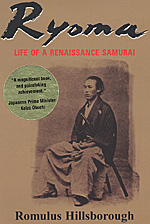 Ridgeback Press, 1999, $40, ISBN: 0-9667401-7-3, 614 pages, hardback
Ridgeback Press, 1999, $40, ISBN: 0-9667401-7-3, 614 pages, hardback
The title word "Renaissance" refers to knowledge about many things, as in "Renaissance Man," not that Ryoma was a samurai in the Renaissance period. Indeed, the period covered represents the mid-19th century, especially the pivotal years in the 1860s.
Sakamoto Ryoma, born November 15, 1835 into the samurai class, laid the foundations of modern Japan, helping transform the feudal system of 260 han (or provinces) ruled by daimyos (feudal lords) into a single nation ruled by the Emperor. His vision for a democratic two-house system of government may have been short-circuited by his assassination in 1867, but his efforts to topple the corrupt Shogun and his Bakufu ministry succeeded after his death.
Hillsborough divides Ryoma's life into three stages: his early years as he travels to study fencing until he became a noted sword master; his days as a ronin outlaw drumming up support for his vision of government amidst the threat of Western colonization; and finally, the economic and military skirmishing that led to the Shogun's resignation.
Ryoma is an odd duck in the samurai system, rejecting the caste structure in favor of a merit-based social and political system. He also has no lack of self-confidence, boosted no doubt by his sword skills that help him fend off assassins, and a clear vision of an independent and unified Japan.
He steadfastly sticks to his vision despite jeers, official prosecution, and threats. Along the way, you learn the, ahem, eccentricities of Ryoma, including an obliviousness to attire, hygiene, and manners. Even his own wife can't stop him from public urination, and his outburst and straightforward talk often creates amusing situations. It's hard to imagine George Washington going to visit Thomas Jefferson, announcing himself to the butler, and then peeing on the rose bush next to the front door. Ryoma's quite a character.
And Hillsborough's quite a storyteller. The book is a biography, but is written more like a novel. At times, especially in the beginning, it's hard to keep switching back and forth between straight bio information and novel-style conversations, but by book's end, you realize you've digested much more than facts and dates. With multiple han to cover and an enormous cast of characters, it's not easy, but give the author credit here. By the end of the book, the prose reads pretty well, in part because you've become accustomed to the method and in part due to a strong writing style.
Ryoma is more than a biography. It's an examination of how a technologically backward nation can gather itself in the face of Western expansion and avoid colonization. It took a civil war to achieve that unity, but like the U.S. it emerged stronger from the contest. Japan can thank a far-sighted samurai for its independence, and we can thank Hillsborough for his far-reaching biography.
Info: Ridgeback Press:
E-mail Ridgeback Press for more information
www.ridgebackpress.com
Also by Romulus Hillsborough:
Back to List of Book Reviews: Colonial Era
Back to Master Book Review List
Back to Master Magazine List
© Copyright 2001 by Coalition Web, Inc.
This article appears in MagWeb.com (Magazine Web) on the Internet World Wide Web.
Other military history articles and gaming articles are available at http://www.magweb.com